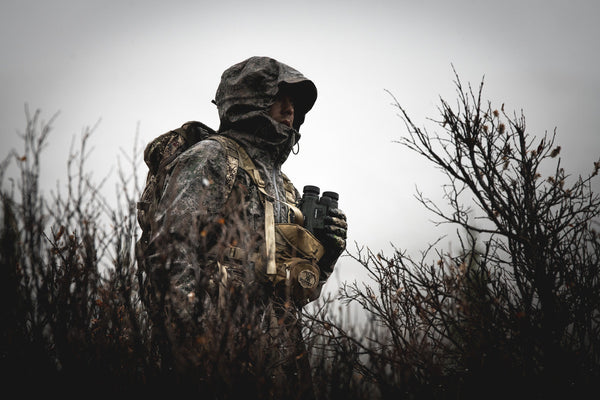Understanding Mule Deer Behavior to Improve Your Hunting Success
Oct 15, 2024
Trophy Mule deer hunting has gained a lot of popularity in the last few decades with some of the coveted governor tags fetching over half a million dollars. There is a solid argument supporting the idea that mule deer are an icon of western big game hunting. Consequently, mule deer herds have been steadily declining due to residential development on critical winter range, predators, disease, drought, and highway mortality to name a few. If you dream of putting one of these magnificent creatures in the back of your truck, understanding their behavior is crucial for success. This article dives into the intricate behaviors of mule deer, offering insights that can fuel your hunting strategy.
Explore Our Premium Mule Deer Hunting Gear
SKRE Gear® features mule deer gear that gives hunters the tools for successful hunts. Upgrade your gear for peak performance
Shop Mule Deer Hunting Gear
Habitat and Range
Mule deer are primarily found in western North America, ranging from the Pacific Coast to the Rocky Mountains, south to Sonora Mexico, and north into Canada. They thrive in a variety of habitats, including mountainous regions, open grasslands, sagebrush plains, and arid deserts. Key factors influencing their habitat preferences include food availability, water sources, and shelter from predators.
Seasonal Habitat Changes
Mule deer are known for their migratory patterns, often moving between summer and winter ranges. Mule deer can migrate from summer to winter more than 100 miles. In summer, they favor higher elevations with abundant forage. As winter approaches, they migrate to lower elevations where food is more accessible.

Understanding these seasonal changes is vital for hunters aiming to locate deer during specific times of the year. Lower elevation deer will have a much shorter range, often spending summer and winter in the same location
Feeding Behavior
Mule deer are browsers, primarily feeding on shrubs, forbs, and grasses. Their diet varies with the seasons and the availability of forage.
Foraging Patterns
Mule deer typically feed during dawn and dusk, known as crepuscular activity. They often graze in open areas but will retreat to cover if they sense danger. Recognizing their feeding patterns can help hunters determine when and where to set up.
Food Preferences
During spring and summer, mule deer seek tender, nutrient-rich plants to build fat reserves. In winter, they rely on woody plants and conifers. Understanding their dietary needs throughout the year can guide hunters in choosing effective locations, especially during the pre-rut and rut periods when deer are more active.
Social Structure and Behavior
Mule deer exhibit a social hierarchy that can influence their behavior. Typically, they form small groups, particularly does, fawns, and yearling bucks while mature bucks are more solitary except during the breeding season. However, it’s worth noting that bucks will run in bachelor herds during the summer and early fall months. This makes it incredibly difficult to stalk into bow range with multiple eyes covering every approach.
Rutting Behavior
The rut occurs in late fall, typically starting in early November and lasting most of the month of November, and is characterized by increased activity among bucks. During this time, bucks are in close proximity to does waiting for a doe to come into estrus. During the peak of the rut, usually mid-November, bucks become more aggressive and hence more visible. Hunters can capitalize on this behavior by scouting areas that harbor groups of does. This is one of the best times of the year to harvest a smart old buck. Unfortunately, very few western states offer hunts during the peak of the rut.
Predator Awareness and Escape Tactics
Mule deer have evolved numerous adaptations to evade predators, including excellent vision, hearing, and a keen sense of smell. Those big old satellite dishes on their head can detect sound at great distances. Often you can observe a mule deer on high alert with one ear pointing forward while the other ear is pointing

backwards. This allows them to detect sound in almost any direction. They also have incredible vision and smell and while you can probably disrupt their visual system by wearing good camouflage and walking quietly you will never fool their nose so having the wind in your face is critical to success.
Escape Routes
Mule deer are adept at navigating their environment to escape threats. They tend to take familiar escape routes, often leading them to steep terrain or dense cover. Hunters should consider these routes when planning their approach, using topography to their advantage. Mule deer, especially a smart old buck, rarely will box himself into a canyon or ravine. They prefer areas with multiple escape routes, and you can bet they understand and utilize those routes with precision.
Explore Our Premium Mule Deer Hunting Gear
SKRE Gear® features mule deer gear that gives hunters the tools for successful hunts. Upgrade your gear for peak performance.
Shop Mule Deer Hunting Gear
Weather Influences on Behavior
Weather can significantly affect mule deer behavior. Changes in temperature, precipitation, and wind can influence feeding patterns, movement, and overall activity levels. I hunted in early November with daytime temps in the 70’s with dry and dusty conditions. It makes for very hard hunting with very few deer active during daylight hours. However, I have been on multiple hunts where a snowstorm will roll in midway through the hunt and drop several inches of snow overnight. When this happens, it can get fun really quick. It’s like someone turned on a light switch and there are suddenly deer everywhere. Weather and temps can make all the difference
Temperature Effects
During hot weather, mule deer are more likely to seek shade and reduce their movement during the day, becoming more active in the early morning and late evening. My experience has been when it’s unseasonably hot the big bucks are all but nocturnal. Conversely, during cooler weather, they may roam more freely throughout the day. Weather can truly make or break a hunt.
Precipitation and Wind
Rain and snow can affect food availability and cover, influencing deer movement. Fresh snow can make foraging easier, while heavy snowfall can drive them out of the high country to lower elevations. Wind can also mask human scent, allowing hunters to be more discreet in their approach.
Scouting and Tracking
Effective scouting is crucial for understanding mule deer behavior. Utilizing trail cameras where legal, observing tracks and heavily used trails, and noting feeding & bedding areas can provide valuable insights into their patterns
Using Technology
Trail cameras have been a hot topic of debate here in the West, but where legal, they can help monitor deer activity, revealing patterns that are not always visible through preseason scouting. Analyzing trail cam photos can provide information on timing, frequency, and even the sex and age of deer in the area. Be sure to utilize mapping software like Google Earth to get a lay of the land and to also

identify water sources, and potential bedding and feeding areas. This will allow you to hit the ground running.
Traditional Scouting Techniques
Hunters who consistently harvest big bucks have one thing in common. They spend a lot of time preseason scouting. Mule deer seasons in the west are typically short, which is why it’s critical to scout as much as you can before opening day. Understanding the terrain and the deer’s preferred habitats can and will lead to more successful hunts. Purchase the best optics you can afford, get on a high point, and glass, glass, glass. This is one of the best ways to observe mule deer behavior
Ethical Hunting Practices
Hunting Ethics is also another very hot topic, but I think we all agree that respecting the animal, and its habitat is essential for sustainable hunting for future generations. Ethical practices extend way beyond personal beliefs and opinions. As hunters we need to adhere to hunting regulations, minimizing disturbance to deer during those difficult winter months, and ensuring a humane kill. If we want hunting to be viewed in a positive light, we all need to do our part.
Conservation
Engaging in responsible hunting contributes to conservation efforts, helping to maintain healthy mule deer populations and their habitats. Understanding the impact of hunting on deer behavior and population dynamics can foster a more respectful relationship between hunters and wildlife. Hunters need to become involved in worthwhile conservation projects
Conclusion
Understanding mule deer behavior is key to improving your odds of punching that tag on the buck of a lifetime. By considering factors such as habitat preferences, feeding behavior, social structures, and environmental influences, hunters can develop effective strategies to locate and harvest these elusive animals. Observation through multiple scouting trips is going to put you in a much more favorable position for success. Ethical hunting and Conservation practices ensure the sustainability of mule deer populations, preserving the sport for future generations. As you prepare for your next hunting season, remember that patience, observation, and respect for wildlife will lead to a more rewarding experience in the field.



